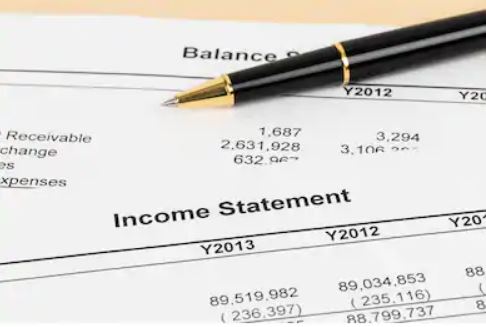The income statement is referred to multiple things at the same time, including- statement of income and expense, statement of profit and loss account. It is a financial statement that consists of a summary of all the operations of a firm at a given time. It displays where the company stands in terms of expenses and incomes and represents a picture of the firm’s revenues, loses, expenses, profits, net income, and earnings per share (EPS).
It is one of the most important financial statements that investors require to be able to look at in case they are considering to invest in a company. The primary purpose of an income statement is to make sure that you are getting the whole image of a company’s revenues and expenses in the financial year. It will show the financial statements of a company that displays the profit and loss for that year. The profit is considered by calculating all the revenues and loses, and then subtracting loses from revenues. There are three financial statements in total, and income statement is one of them which are used in both finance and accounting and corporate.

These statements are divided into different time periods that will logically follow all the operations performed by a company. The most common period that firms follow is monthly calculation, usually for internal reporting. On the other hand, a lot of companies even use a thirteen-period cycle. The monthly statements are gathered and then added up into total values to find annual and quarterly results. Starting with income statement is a great option when you are beginning with the financial model. You may ask why? This is because you do not require a lot of information from the balance sheet and cash flow statement to prepare an income statement. So, in terms of knowledge, the income statement will come first, and then the other two statements.
Check:
- Profit Margin Definition, Formula and How to Calculate It?
- Unadjusted Trial Balance Format and Purpose with Examples
Example:
Given below is an example of an income statement.
| IS Global, Inc. | |||
| (Consolidated) Statement of Income and Expense | |||
| for the year ended 31 December | |||
| Notes | 2013 | 2012 | |
| Revenue | 14 | 201.9 | 182.1 |
| Cost of sales | 15 | (158.4) | (151.6) |
| Gross profit | 43.5 | 30.5 | |
| Selling and distribution expenses | 16 | (9.8) | (8.9) |
| General and administrative expenses | 17 | (14.0) | (11.0) |
| Other operating income and gains | 18 | 1.8 | 2.6 |
| Other operating expenses and losses | 19 | (3.4) | (1.3) |
| Operating profit/earnings before interest and taxes (EBIT) | 18.1 | 11.9 | |
| Interest income | 20 | 1.3 | 0.6 |
| Interest expense | 20 | (3.6) | (2.8) |
| Net interest expense | 20 | (4.9) | (3.4) |
| Profit from investments under the equity method | 22 | 6.9 | 5.5 |
| Earnings before taxes | 20.1 | 14.0 | |
| Income taxes | 23 | (6.0) | (4.2) |
| Income from continuing operations | 14.1 | 9.8 | |
| Income from discontinued operations | 24 | 2.1 | 3.1 |
| Net income | 17 | 16.2 | 12.9 |
| Distribution of net income: | |||
| Equity-holders of parents | 14.6 | 11.6 | |
| Non-controlling interest-holders | 1.6 | 1.3 | |
| Earnings per share: | 19 | ||
| Basic, attributable parent | 0.15 | 0.12 | |
| Diluted, attributable to the parent | 0.15 | 0.11 | |
| Basic, from continued operations, attributable to the parent | 0.14 | 0.10 | |
| Diluted, from continued operations, attributable to the parent | 0.14 | 0.09 | |
All amounts except for Earnings Per Share are in million USD.
Format:
A typical income statement is supposed to be in a report form. The lines written in the header identifies the company, the statement, and the period at which the statement will release. It also includes the currency and the level at which it is rounded-off. After the header, you will have to cover all the revenue items and cost of goods sold and calculating the gross profit. After this statement, you will have to include in detail the expenses, including operating expenses, non-operating expenses, and taxes. After this will come the statements which will display the difference between incomes earned from continuing operations and the total net income. If the income statement is consolidated, distribution of net income between the non-controlling interest holders and equity-holders of the parent company will also be present. Lastly, the statement will end with a display of earnings per share of both diluted and basic.
Check:
- Newton-Raphson Method Formula and Explanation Guide
- Current Liabilities Definition, Objectives, and Importance
Types:
There are two primary types of the income statement: the first one is a single-step income statement which does not comprise of sub-totals, that is, no gross profit, operating income, earnings before tax, etc. The second one is a multi-step income statement which expenses of similar types are grouped together, and intermediate figures, including gross profit, operating income, and EBIT, etc. are calculated.
There is another division of income statement that depends on the nature of expenses. Are they grouped by their function or nature? The income statement that is defined by its nature includes all the costs according to their nature, that is, without assigning to different activities of the business. On the flip side, the income statement that is defined by its function includes expenses depending on the operations of the business that they support. For example, an income statement that depends on nature will display all the items, including salaries, rent, depreciation, etc. On the other hand, income statement depending on function will include salaries, depreciation, rent, etc. between the cost of goods sold, general and admin expense, selling expense, etc.
Components of an Income Statement:

The income statement comprises of different components which might vary between different companies. This is because the income and expenses of different companies are separate and depends on the type of operations conducted. Given below are a few components of the income statement:
Revenue- It mentions the company’s revenue that is derived from sales or offering services. This is displayed at the very top of the financial statement.
Cost of Goods Sold (COGS) –It summarizes the direct costs that are associated with selling the products in order to generate income and profits. It is also known as the cost of sales in a service company.
Gross Profit- It is calculated by subtracting the cost of goods sold from the sales revenue.
There are other components, too; these were only a few of them. You can read more about these components in detail if you want to know what these entries mean and where and when to place them.


